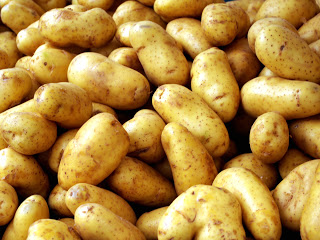 |
| Image courtesy Stock.Xchng / JR3 |
You say “potato.” I say “rosemary-kissed, oven-roasted fingerlings?”
The way we talk about food matters. You and I could be talking about the exact same thing – say, a spud, or a particular dish, or a favorite recipe – but the words we use to talk about it convey much more than just what’s literally in front of us on the dinner plate.
Is the food something generic to eat? (A potato.) Or something specific to be appreciated? (A seasoned, roasted fingerling.)
Are we connected to the food we eat, or dispassionate and ignorant of the journey it took from field to fork?
Are we humble in the face of nature’s/agriculture’s bounty, or pretentious food snobs who prefer to “elevate” descriptions of our food?
Do we convey usefully specific information? (Hey, this potato is seasoned with rosemary!) Do we convey a region it came from, giving a nod to the influence of terroir on the food we eat? (A Long Island North Fork sweet corn, say, vs. a Colorado Olathe sweet corn.)
Or are we over-descriptive simply for the sake of being so, and stating the obvious? (Is oven-roasted really necessary? Where else might you roast a potato? In the Friars Club, telling sarcastic jokes to and about your potato, meaning to flatter it while simultaneously insulting and humiliating it?)
There’s a balance to be struck, I think, between too much and too little information in the descriptions we use to tell people about our food. And in this day and age, when supermarkets and commerce threaten to disconnect us more than ever from the sources of our food, I’d wager that we ought to err in the direction of the former, toward too much information.
Locavore restaurants and foodies have been doing this for a little while now (and some supermarkets are getting in on the act, too). On a menu you might see the name of a particular local ranch precede the name of the steak. Or it might specify “grass-fed” beef, or “pastured” eggs. Or it might note the particular heirloom variety of tomato, or the farm that the tomato came from. This is a good thing.
Just as the convenience and size and scale and disconnect of the supermarket has separated us (in some respects) from the land, language is connecting us back to the landscape. As a writer, I love this power that words can have.
An example:
Suppose you’re planning dinner one night, and someone asks what you’re having. How might they react to the following spectrum of responses, which all describe the exact same thing?
“We’re having chicken and vegetables.” (Ho hum. I could take it or leave it.)
“We’re having grilled chicken with roasted veggies.” (Sounding better. I’m always down for a little grill action.)
“We’re having grilled chicken marinated in a red wine vinaigrette, paired with roasted Brussels sprouts tossed in olive oil, salt, pepper and a bit of garlic powder.” (Yee haw! No we’re talking! Do you have an extra seat at the table?)
“We’re having a lovely grilled chicken, marinated with a red wine vinaigrette. I made the vinaigrette from scratch. I just loathe those store-bought varieties. They taste so…fake. Did I mention that I made my own red wine vinegar, fermenting grapes pressed with my bare feet in the hills of Tuscany? That’s really the only way to produce tolerable red wine vinegar. Oh, and the roasted Brussels sprouts. They’re to die for. Not literally, of course. But the olive oil I use to toss them…it’s cold-pressed. Very expensive stuff. They ship the olives to northern Canada, where native Inuit press them between mill wheels carved of solid clear ice.” (Prick. Enjoy your dinner. How many Michelin stars does your home kitchen have? Are the Zagats swinging by?)
That last example is way over the top, but you get my drift.
When we talk about the food we eat, in this day and age, sometimes more is more. More descriptive food language helps us build better relationships with that food. It’s like getting to know a good friend, or a significant other. They’re not just a person. You know more intimate details about them, and that deepens the relationship.
As I said at the outset, the way we talk about food matters. A potato is just a potato, unless we rightly make it something greater…
– Pete
Potatoes are the only vegetable that have protein in them. You want to eat proteins,carbohydrates and fats in every meal. You can eat a potato by itself just make sure you have some fat with it.
Sorry, Bill, but potatoes are hardly the only “vegetable” with protein. In fact, while potatoes do have some protein, they’re mostly carbs. There are scores of plant-based protein sources…beans, nuts, seeds, legumes, Brussels sprouts, brown rice, quinoa, and the list goes on and on. Per serving, most of these have significantly more protein than potatoes.
Cheers, Pete